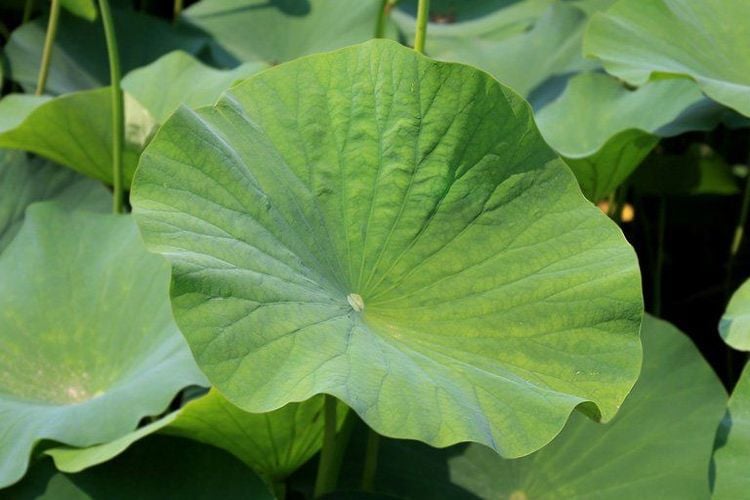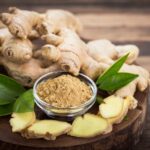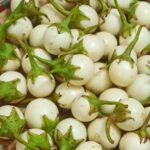During the summer, it’s a common sight to behold vast and lush fields of lotus plants across Vietnam. Typically, farmers harvest the flowers, seeds, and tubers for sale, with the leaves often being discarded. However, recently, people have realized that these discarded leaves are actually a “gold mine,” fetching prices of up to 200,000 VND per kg.
The Benefits of Lotus Leaves
In the past, lotus leaves were often thrown away by lotus farmers, with little attention paid to their potential value. Some thrifty individuals would use them for wrapping sticky rice or green rice cakes, enhancing the aroma and flavor without the need for additional packaging. Nevertheless, these leaves have now found a new purpose as tea, selling for up to 200,000 VND per kg, although many are still unaware of this.

Lotus leaves can be made into tea and sold for up to 200,000 VND per kg
Lotus farmers share that there is a growing demand for lotus leaves in the tea industry, as they offer numerous health benefits that are not commonly known. Traditionally, fresh lotus leaves were used in folk medicine to treat common ailments such as sunstroke, diarrhea, and stomachaches. Dried lotus leaves, on the other hand, can be used to treat hemorrhages.
According to health experts, drinking lotus leaf tea in conjunction with proper exercise can aid in weight loss and maintaining a slim figure effectively and safely without causing fatigue. It is recommended to consume lotus leaf tea at least 30 minutes before a meal or one hour after to avoid any interference with digestion.
However, experts also caution that lotus leaves may not be suitable for individuals with a cold body constitution. Those with a cold constitution may experience fatigue, memory loss, palpitations, and decreased sexual function when consuming lotus leaves. Therefore, it is advised to consult a doctor before using lotus leaves to treat insomnia, as one’s body constitution should be taken into account to avoid any adverse effects.
Additionally, pregnant and lactating women, as well as those menstruating, are advised against consuming lotus leaves, as it may negatively impact their health.
Lotus Leaves Provide a Significant Income Source for Farmers

Lotus is a crop that significantly improves farmers’ income.
Mr. Vu from Nam Dinh province shared that his family has been making lotus leaf tea for three years, but their supply is limited. He explained, “For lotus plants harvested for their flowers, I can also collect the leaves to sell in the market. However, for the ponds where we harvest the tubers, I have to leave the leaves to nourish the tubers.”
As his family mainly focuses on tuber production and developing related products, they have a limited supply of leaves for tea, which they sell for 200,000 VND per kg dry weight.
To prepare the leaves for tea, they are washed, cut into small pieces, and sun-dried. Currently, towards the end of the lotus season, the availability of leaves is decreasing.
Lotus leaves are not only used for tea but also for creating paintings that can fetch prices of up to millions of VND per painting.
Lotus cultivation has proven to be a lucrative venture for farmers, with many households in Hung Ha district, Thai Binh province, reporting income five times higher than that of rice farming. This is attributed to the sale of lotus leaves, which are priced between 15,000 and 30,000 VND per kg.
The Surprising Reason Most Japanese People Choose to Sleep on the Floor Instead of in a Bed
The Japanese have a unique cultural practice of sleeping on the floor instead of in beds. This tradition has garnered intrigue and curiosity from the rest of the world, with many wondering why they opt for this seemingly uncomfortable sleeping arrangement. Unraveling this mystery reveals a deep-rooted connection to their cultural heritage and a myriad of surprising health benefits.
“The Secret to Perfectly Pickled Cauliflower: A Step-by-Step Guide to Achieving Bright White, Crisp, and Support-Free Results”
Introducing the ultimate guide to achieving perfectly pickled white cauliflower – crisp, tangy, and free from unsightly discoloration. Unveil the secrets to creating a crunchy, vibrant treat that will impress and delight, with a technique so masterful it borders on art. Learn how to transform ordinary cauliflower into a mouthwatering delicacy, a true testament to your culinary prowess. Get ready to impress!




































